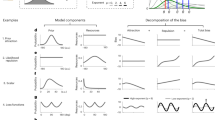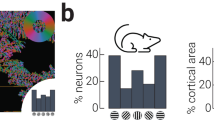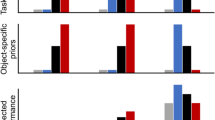Abstract
Bayesian observer models provide a principled account of the fact that our perception of the world rarely matches physical reality. The standard explanation is that our percepts are biased toward our prior beliefs. However, reported psychophysical data suggest that this view may be simplistic. We propose a new model formulation based on efficient coding that is fully specified for any given natural stimulus distribution. The model makes two new and seemingly anti-Bayesian predictions. First, it predicts that perception is often biased away from an observer's prior beliefs. Second, it predicts that stimulus uncertainty differentially affects perceptual bias depending on whether the uncertainty is induced by internal or external noise. We found that both model predictions match reported perceptual biases in perceived visual orientation and spatial frequency, and were able to explain data that have not been explained before. The model is general and should prove applicable to other perceptual variables and tasks.
This is a preview of subscription content, access via your institution
Access options
Subscribe to this journal
Receive 12 print issues and online access
$209.00 per year
only $17.42 per issue
Buy this article
- Purchase on Springer Link
- Instant access to full article PDF
Prices may be subject to local taxes which are calculated during checkout








Similar content being viewed by others
References
Attneave, F. Some informational aspects of visual perception. Psychol. Rev. 61, 183 (1954).
Barlow, H.B. Possible principles underlying the transformation of sensory messages. in Sensory Communication (ed. Rosenblith, W.A.) 217–234 (MIT Press, 1961).
Olshausen, B.A. & Field, D.J. Emergence of simple-cell receptive field properties by learning a sparse code for natural images. Nature 381, 607–609 (1996).
Dan, Y., Atick, J.J. & Reid, R.C. Efficient coding of natural scenes in the lateral geniculate nucleus: Experimental test of a computational theory. J. Neurosci. 16, 3351–3362 (1996).
Lewicki, M.S. Efficient coding of natural sounds. Nat. Neurosci. 5, 356–363 (2002).
Helmholtz, H. Treatise on Physiological Optics (transl.) (Thoemmes Press, Bristol, UK, 2000).
Curry, R.E. A Bayesian model for visual space perception. in Seventh Annual Conference on Manual Control NASA SP-281, 187ff (NASA, 1972).
Knill, D.C. & Richards, W. Perception as Bayesian Inference (Cambridge University Press, 1996).
Körding, K.P. & Wolpert, D. Bayesian integration in sensorimotor learning. Nature 427, 244–247 (2004).
Stocker, A.A. & Simoncelli, E.P. Noise characteristics and prior expectations in human visual speed perception. Nat. Neurosci. 9, 578–585 (2006).
van den Berg, R., Vogel, M., Josic, K. & Ma, W.J. Optimal inference of sameness. Proc. Natl. Acad. Sci. USA 109, 3178–3183 (2012).
Jazayeri, M. & Shadlen, M.N. Temporal context calibrates interval timing. Nat. Neurosci. 13, 1020–1026 (2010).
Jones, M. & Love, B.C. Bayesian fundamentalism or enlightenment? On the explanatory status and theoretical contributions of Bayesian models of cognition. Behav. Brain Sci. 34, 169–188 (2011).
Bowers, J.S. & Davis, C.J. Bayesian just-so stories in psychology and neuroscience. Psychol. Bull. 138, 389 (2012).
Tomassini, A., Morgan, M.J. & Solomon, J.A. Orientation uncertainty reduces perceived obliquity. Vision Res. 50, 541–547 (2010).
Girshick, A.R., Landy, M.S. & Simoncelli, E.P. Cardinal rules: visual orientation perception reflects knowledge of environmental statistics. Nat. Neurosci. 14, 926–932 (2011).
Geisler, W.S., Najemnik, J. & Ing, A.D. Optimal stimulus encoders for natural tasks. J. Vis. 9, 17.1–17.16 (2009).
Burge, J. & Geisler, W.S. Optimal defocus estimation in individual natural images. Proc. Natl. Acad. Sci. USA 108, 16849–16854 (2011).
Brayanov, J.B. & Smith, M.A. Bayesian and “Anti-Bayesian” biases in sensory integration for action and perception in the size-weight illusion. J. Neurophysiol. 103, 1518–1531 (2010).
Wei, X.-X. & Stocker, A.A. Efficient coding provides a direct link between prior and likelihood in perceptual Bayesian inference. Adv. Neural Inf. Process. Syst. 25, 1313–1321 (2012).
Linsker, R. Self-organization in a perceptual network. Computer 21, 105–117 (1988).
Brunel, N. & Nadal, J.-P. Mutual information, Fisher information, and population coding. Neural Comput. 10, 1731–1757 (1998).
McDonnell, M.D. & Stocks, N.G. Maximally informative stimuli and tuning curves for sigmoidal rate-coding neurons and populations. Phys. Rev. Lett. 101, 058103 (2008).
Ganguli, D. & Simoncelli, E.P. Implicit encoding of prior probabilities in optimal neural populations. Adv. Neural Inf. Process. Syst. 23, 658–666 (2010).
Fechner, G.T. Elemente der Psychophysik (Breitkopf und Haertel, Leipzig, 1860).
Stocker, A.A. & Simoncelli, E.P. Sensory adaptation within a Bayesian framework for perception. Adv. Neural Inf. Process. Syst. 18, 1289 (2006).
Webb, B.S., Ledgeway, T. & McGraw, P.V. Relating spatial and temporal orientation pooling to population decoding solutions in human vision. Vision Res. 50, 2274–2283 (2010).
Putzeys, T., Bethge, M., Wichmann, F., Wagemans, J. & Goris, R. A new perceptual bias reveals supoptimal population decoding of sensory responses. PLoS Comput. Biol. 8, e1002453 (2012).
Switkes, E., Mayer, M.J. & Sloan, J.A. Spatial frequency analysis of the visual environment: anisotropy and the carpentered environment hypothesis. Vision Res. 18, 1393–1399 (1978).
Coppola, D.M., Purves, H.R., McCoy, A.N. & Purves, D. The distribution of oriented contours in the real world. Proc. Natl. Acad. Sci. USA 95, 4002–4006 (1998).
Jastrow, J. Studies from the University of Wisconsin: on the judgment of angles and positions of lines. Am. J. Psychol. 5, 214–248 (1892).
de Gardelle, V., Kouider, S. & Sackur, J. An oblique illusion modulated by visibility: non-monotonic sensory integration in orientation processing. J. Vis. 10, 6 (2010).
Ruderman, D.L. The statistics of natural images. Network 5, 517–548 (1994).
Dong, D.W. & Atick, J.J. Statistics of natural time-varying images. Network 6, 345–358 (1995).
Campbell, F.W. & Robson, J.G. Application of Fourier analysis to the visibility of gratings. J. Physiol. (Lond.) 197, 551 (1968).
Georgeson, M.A. & Ruddock, K.H. Spatial frequency analysis in early visual processing. Phil. Trans. R. Soc. Lond. B [and discussion] 290, 11–22 (1980).
Körding, K.P. & Wolpert, D. The loss function of sensorimotor learning. Proc. Natl. Acad. Sci. USA 101, 9839–9842 (2004).
Wang, Z., Stocker, A.A. & Lee, D.D. Optimal neural tuning curves for arbitrary stimulus distributions: Discrimax, Infomax and minimum Lp loss. Adv. Neural Inf. Process. Syst. 25, 2177–2185 (2012).
Salinas, E. How behavioral constraints may determine optimal sensory representations. PLoS Biol. 4, e387 (2006).
Ganguli, D. & Simoncelli, E.P. Efficient sensory encoding and Bayesian inference with heterogeneous neural populations. Neural Comput. 26, 2103–2134 (2014).
Simoncelli, E.P. & Olshausen, B.A. Natural image statistics and neural representation. Annu. Rev. Neurosci. 24, 1193–1216 (2001).
Laughlin, S.B. A simple coding procedure enhances a neuron's information capacity. Z. Naturforsch. C. 36, 910–912 (1981).
Stilp, C.E. & Kluender, R.K. Efficient coding and statistically optimal weighting of covarinace among acoustic attributes in novel sounds. PLoS ONE 7, e30845 (2012).
Chalk, M., Seitz, A.R. & Series, P. Rapidly learned stimulus expectations alter perception of motion. J. Vis. 10, 2 (2010).
Crane, B.T. Direction specific biases in human visual and vestibular heading perception. PLoS ONE 7, e51383 (2012).
Cuturi, L.F. & MacNeilage, P.R. Systematic biases in human heading estimation. PLoS ONE 8, e56862 (2013).
Rose, D. & Blakemore, C. An analysis of orientation selectivity in the cat's visual cortex. Exp. Brain Res. 20, 1–17 (1974).
Gu, Y., Fetsch, C.R., Adeyemo, B., DeAngelis, G.C. & Angelaki, D.E. Decoding of MSTd population activity accounts for variations in the precision of heading perception. Neuron 66, 596–609 (2010).
Fischer, B.J. Bayesian estimates from heterogeneous population codes. Proc. Int. Jt. Conf. Neural Netw., 1–7 (IEEE, 2010).
Wei, X.-X. & Stocker, A.A. Bayesian inference with efficient neural population codes. in Artificial Neural Networks and Machine Learning–ICANN 2012 (eds. Villa, A., Duch, W., Erdi, P., Masulli, F. & Palm, G.) 523–530 (Springer, 2012).
Kullback, S. & Leibler, R.A. On information and sufficiency. Ann. Math. Stat. 22, 79–86 (1951).
Mr. Bayes & Mr. Price. An essay towards solving a problem in the doctrine of chances, by the late Rev. Mr. Bayes, F. R. S. communicated by Mr. Price, in a letter to John Canton, A. M. F. R. S. Philos. Trans. 53, 370–418 (1763).
Acknowledgements
We thank V. DeGardelle, S. Kouider and J. Sackur for providing their data. We also would like to express our gratitude to E. Salinas, J. Gold and D. Swingley for providing valuable feedback on previous versions of the manuscript. The work was supported by the Office of Naval Research (grant N000141110744) and the University of Pennsylvania (including a Benjamin Franklin fellowship to X.-X.W.).
Author information
Authors and Affiliations
Contributions
Both authors jointly designed and performed the research, and wrote the paper.
Corresponding author
Ethics declarations
Competing interests
The authors declare no competing financial interests.
Supplementary information
Supplementary Methods Checklist
Supplementary Information (PDF 352 kb)
Rights and permissions
About this article
Cite this article
Wei, XX., Stocker, A. A Bayesian observer model constrained by efficient coding can explain 'anti-Bayesian' percepts. Nat Neurosci 18, 1509–1517 (2015). https://doi.org/10.1038/nn.4105
Received:
Accepted:
Published:
Issue Date:
DOI: https://doi.org/10.1038/nn.4105



